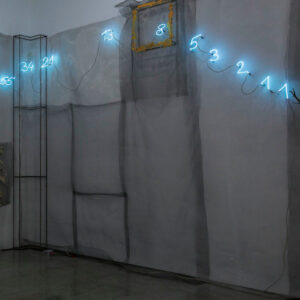Wednesday, November 9, Gladstone Gallery has opened its doors to Mario Merz. Early Works, an exhibition of historic early works by the Italian master of Arte Povera, the movement which blossomed in Italy in the 1960s and 70s. Together with international artists such as Alighiero Boetti, Michelangelo Pistoletto and Janis Kounellis, Mario Merz is considered among the leading members of this artistic movement, which unquestionably changed the definition of art long before similar groups ― Brit Art, for instance ― came to the fore.
By advocating the use of impoverished materials and pursuing an anti-consumerist ideology, the “Poveristi” moved away from the commodification of Pop Art and the detachment of American Minimalism, and as such put existing artistic models into question.
Organized in collaboration with Fondazione Mario Merz, the exhibition highlights three major seminal works by the artist featuring some of his signature motifs: the igloo, the Fibonacci sequence, and the use of neon.
Simone Battisti, Gladstone Gallery Director, was pleased to tell us that the gallery joined forces with Beatrice Merz, President of the Fondazione and Mario’s daughter, and with Marisa Merz, the artist’s widow. Together they decided to plan a special show focused on Merz’s early oeuvre. They selected three installations coming both from Beatrice Merz’s collection and from private collections ― spanning from 1968 to 1977.
Gladstone Gallery is actually not new to Merz’s work. “Mario Merz’s art, as well as his wife’s, are part of Gladstone’s DNA: we have already exhibited his and her pieces in the past”, added Battisti, “so these three installations keep on a long-lasting tradition between the gallery and Merz family.”
Made of dried mud, Giap Igloo is a dome-shaped structure bearing in neon letters the words of Vietcong General Vo Nguyen Giap of the Vietnamese National Liberation Front, “If the Enemy Masses His Forces, He Looses Ground: If He Scatters, He Loses Strength.” Merz’s renowned igloos are archetypical bodies, which express his preoccupation with the fundamentals of human existence: shelter, food and man’s relationship to nature. He used to define the igloo as “the ideal organic form, a construction to provide refuge,” and claimed that his intention was “to create an architecture that begins from within and expands outwards.”

 Leyden Jar takes over an entire room of the gallery, covering each wall in wire net with a neon-lit Fibonacci progression of numbers which erupts from the natural form of a branch. Merz has had a long fascination with the Fibonacci series, the sequence formed by adding a number to the number preceding it, and possibly evoking an order that, in a chaos-dominated world, can unite all.
Leyden Jar takes over an entire room of the gallery, covering each wall in wire net with a neon-lit Fibonacci progression of numbers which erupts from the natural form of a branch. Merz has had a long fascination with the Fibonacci series, the sequence formed by adding a number to the number preceding it, and possibly evoking an order that, in a chaos-dominated world, can unite all.
The third work, Sitin, is a box-shaped sculpture whose title refers to the political act of occupying a space with one’s own body, as “sitting” is both an individual and a social action. Since Arte Povera was a deeply political movement, a revolutionary genre freed from convention and from the market-place laws, Merz often used political slogans or hints to activism for some of his metaphorical works like this one.
According to Director Battisti, nowadays Merz’s works impact not only on the viewer, but also on a whole generation of artists, that infuse their own art with Arte Povera patterns such as, for instance, humbleness of materials and political engagement. Mr. Battisti also confirmed that American collectors have always been ― and currently are ― very keen on Arte Povera, which along with Minimalism, can be seen as one of the last prominent movements of the 20th century.
Meaningfully, the opening day of the exhibition, November 9, coincides with the 13th anniversary of the artist’s death ― Merz died in 2003. Hence, Early Works stands also as a remarkable tribute to a master whose inventive and thought-provoking aesthetics could never be praised enough. The exhibit will be open through December 17, 2016.











